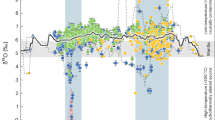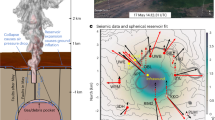Abstract
Characteristic features of many porphyritic andesite and dacite lavas are that they are rich in crystals and display a range of disequilibrium features, including reversely zoned crystals, resorption surfaces, wide ranges of mineral compositions and minerals which are not in equilibrium with the surrounding rock matrix. These features are often interpreted as evidence of the mixing of magmas of contrasting composition, temperature and origin1,2. Here, however, we propose that such features can also be caused by convection within a magma body with a single composition, that is heated from below and cooled from above. We describe petrological observations of andesite lava erupted at the Soufrière Hills volcano, Montserrat, which indicate a heating event and the intermingling of crystals that have very different thermal histories. We present experimental data on a representative groundmass composition of this lava, which indicate that it is difficult to explain the calcic compositions of plagioclase overgrowth rims and microphenocrysts unless parts of the magma were at temperatures much higher than the inferred average temperature. The concept of convective self-mixing allows us to explain the occurrence of compositions of minerals that apparently cannot coexist under equilibrium conditions.
This is a preview of subscription content, access via your institution
Access options
Subscribe to this journal
Receive 51 print issues and online access
$199.00 per year
only $3.90 per issue
Buy this article
- Purchase on Springer Link
- Instant access to full article PDF
Prices may be subject to local taxes which are calculated during checkout


Similar content being viewed by others
References
Heiken, G. & Eichelberger, J. C. Eruptions at Chaos Crags, Lassen Volcanic National Park, California. J. Volcanol. Geotherm. Res. 7, 443–481 (1980).
Clynne, M. A. A complex magma mixing origin for rocks erupted in 1915, Lassen Peak, California. J. Petrol. 40, 105–132 (1999).
Devine, J. D. et al. Petrologic evidence for pre-eruptive pressure–temperature conditions, and recent reheating, of andesitic magma erupting at the Soufrière Hills Volcano, Montserrat, WI. Geophys. Res. Lett. 25, 3669–3672 (1998).
Murphy, M. D., Sparks, R. S. J., Barclay, J., Carroll, M. R. & Brewer, T. S. Remobilisation of andesite magma by intrusion of mafic magma at the Soufrière Hills Volcano, Montserrat, West Indies. J. Petrol. 41, 21–42 (2000).
Kawamoto, T. Dusty and honeycomb plagioclase: indicators of processes in the Uchino stratified magma chamber, Izu Peninsula, Japan. J. Volcanol. Geotherm. Res. 48, 191–208 (1992).
Tsuchiyama, A. Dissolution kinetics of plagioclase in the melt of the system diopside–albite–anorthite, and origin of dusty plagioclase in andesites. Contrib. Mineral. Petrol. 89, 1–16 (1985).
Barclay, J. et al. Experimental phase equilibria constraints on pre-eruptive storage conditions of the Soufrière Hills magma. Geophys. Res. Lett. 25, 3437–3440 (1998).
Snyder, D. Thermal effects of the intrusion of basaltic magma into a more silicic magma chamber and implications for eruption triggering. Earth Planet. Sci. Lett. 175, 257–273 (2000).
Turcotte, D. L. & Schubert, G. Geodynamics: Applications of Continuum Physics to Geological Problems (Wiley, New York, 1982).
Whitehead, J. A. & Luther, D. S. Dynamics of laboratory diapir and plume models. J. Geophys. Res. 80, 705–717 (1975).
Jellinek, A. M., Kerr, R. C. & Griffiths, R. W. Mixing and compositional stratification produced by natural convection, 1. Experiments and their application to Earth's core and mantle. J. Geophys. Res. 104, 7183–7201 (1999).
Jellinek, A. M. & Kerr, R. C. Mixing and compositional stratification produced by natural convection, 2. Applications to the differentiation of basaltic and silicic magma chambers and komatiite lava flows. J. Geophys. Res. 104, 7203–7218 (1999).
Swanson, S. E. Relation of nucleation and crystal-growth rate to the development of granitic textures. Am. Mineral. 62, 966–978 (1977).
Muncill, G. E. & Lasaga, A. C. Crystal-growth kinetics of plagioclase in igneous systems: Isothermal H2O-saturated experiments and extension of a growth model to complex silicate melts. Am. Mineral. 73, 982–992 (1988).
Harford, C. L. & Sparks, R. S. J. Recent remobilisation of shallow-level intrusions on Montserrat revealed by hydrogen isotope composition of amphibole. Earth Planet. Sci. Lett. 185, 285–297 (2001).
Pallister, J. S., Hoblitt, R. P. & Reyes, A. G. A basalt trigger for the 1991 eruptions of Pinatubo volcano. Nature 356, 426–428 (1992).
Nakada, S. & Motomura, Y. Petrology of the 1991–1995 eruption at Unzen: effusion pulsation and groundmass crystallisation. J. Volcanol. Geotherm. Res. 89, 173–196 (1999).
Sato, H., Nakada, S., Fujii, T., Nakamura, M. & Suzuki-Kamata, K. Groundmass pargasite in the 1991–1995 dacite of Unzen volcano: phase stability experiments and volcanological implications. J. Volcanol. Geotherm. Res. 89, 197–212 (1999).
Nekvasil, H. Ascent of felsic magmas and formation of rapakivi. Am. Mineral. 76, 1279–1290 (1991).
Hibbard, M. J. The magma mixing origin of mantle feldspars. Contrib. Mineral. Petrol. 76, 158–170 (1981).
Stimac, J. A. & Wark, D. A. Plagioclase mantles on sanidine in silicic lavas, Clear Lake, California: Implications for the origin of rapakivi texture. Geol. Soc. Am. Bull. 104, 728–744 (1992).
D'Lemos, R. S. Mixing between granitic and dioritic crystal mushes, Guernsey, Channel Islands, UK. Lithos 38, 233–257 (1996).
Vernon, R. H. Microgranitoid enclaves in granites—globules of hybrid magma quenched in a plutonic environment. Nature 309, 438–439 (1983).
Furman, T. & Spera, F. J. Co-mingling of acid and basic magma with implications for the origin of mafic I-type xenoliths: field and petrochemical relations of an unusual dike complex at Eagle Lake, Sequoia National Park, California, USA. J. Volcanol. Geotherm. Res. 24, 151–178 (1985).
Blundy, J. & Sparks, R. S. J. Petrogenesis of mafic inclusions in granitoids of the Adamello Massif. J. Petrol. 33, 1039–1104 (1992).
Acknowledgements
S.C. acknowledges a NERC studentship, R.S.I.S. a NERC professorship and M.R.C. support from the Gruppo Nazionale de Vulcanologia.
Author information
Authors and Affiliations
Corresponding author
Rights and permissions
About this article
Cite this article
Couch, S., Sparks, R. & Carroll, M. Mineral disequilibrium in lavas explained by convective self-mixing in open magma chambers. Nature 411, 1037–1039 (2001). https://doi.org/10.1038/35082540
Received:
Accepted:
Issue Date:
DOI: https://doi.org/10.1038/35082540
This article is cited by
-
What can we learn from geothermobarometry at the dacitic Doña Juana Volcanic Complex (Colombia)? Implications for understanding Pleistocene crystal mushes and pre-eruptive storage conditions in the Northern Andes
Contributions to Mineralogy and Petrology (2024)
-
Petrology, geochemistry, and crystal size distribution of the basaltic andesite–dacite association at Mt. Sumbing, Central Java, Indonesia: Insights to magma reservoir dynamics and petrogenesis
Acta Geochimica (2024)
-
Priming and eruption of andesite magmas at Taranaki volcano recorded in plagioclase phenocrysts
Bulletin of Volcanology (2023)
-
Generation of Neogene adakitic-like magmas in the Argentine Puna-Eastern Cordillera transition: the Huachichocana Subvolcanic Complex
International Journal of Earth Sciences (2023)
-
Mineralogy and petrology of lamprophyre and dolerite dykes from the end-Cretaceous (~ 66 Ma) Phenaimata alkaline igneous complex, north-western India: evidence for open magma chamber fractionation, mafic recharge, and disaggregation of crystal mush zone in a large igneous province
Mineralogy and Petrology (2023)
Comments
By submitting a comment you agree to abide by our Terms and Community Guidelines. If you find something abusive or that does not comply with our terms or guidelines please flag it as inappropriate.



